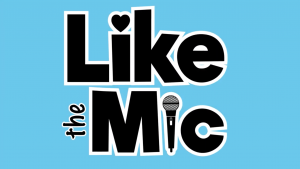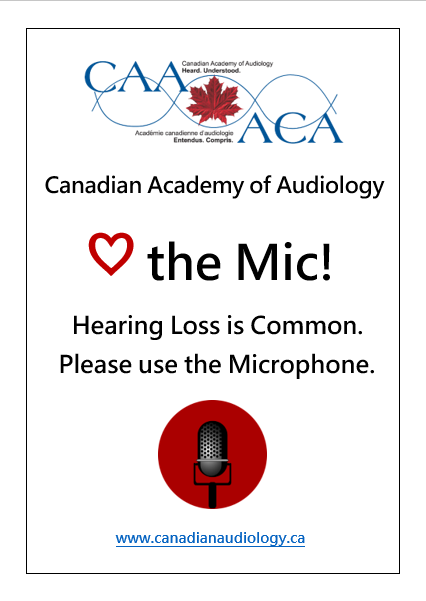Can You Hear Me in the Back? The Answer is No!
Top 6 Reasons to ALWAYS use a Microphone when Public Speaking
Issues in Accessibility
Janine Verge, AuD, Aud (C) is coordinating the “Issues in Accessibility,” column which will cover topics addressing issues in accessibility for people who are Deaf/deaf and hard of hearing.

How many times have you been at a public event and the presenter asks if everyone in the back can hear?
This is presumably to check in with the audience to make sure that everyone is doing okay. But isn't it a just clever maneuver so that the speaker can avoid using the microphone that is sitting right there in front of them?
As someone living with hearing loss, I always get frustrated when I hear this question. It forces individuals who have hearing/listening/attention challenges to publicly “out themselves” as having a problem; it makes people feel as though they’re causing a fuss if they speak up.
Presenters need to stop asking this question; they should just assume that the answer is always NO. Everyone should always wear or use a microphone when speaking in public and here is why:
- The Learning Environment
Whether in a classroom, meeting room, auditorium, theatre, or lecture hall, the environment where events occur are typically difficult to hear. Challenges include excessive background noise (e.g., the hum of lights, outside traffic, audience members talking or moving their chairs, people in hallway talking or coughing), reverberation, poor acoustics, poor lighting, sitting at a distance, and the communication skills of the presenter (e.g., talking with back turned to the audience, not repeating questions from audience members, fast talker, etc.). Although these are barriers that should be individually dealt with to improve the learner’s listening ability, one solution that can make a big difference is the use of a microphone. These challenges not only affect adults but children too. According to the Speech-Language & Audiology Canada (SAC) 2019 position paper on classroom acoustics in classrooms1:- Children often work in classrooms with noise levels equal to or higher than the level of the teacher’s voice, which leaves students listening in a “sea of noise.”2–4To give you an idea of the noise level, it has been shown that the average level of background noise in a classroom is about 60 decibels (dB), which is about the sound of a small hairdryer. This is very concerning because the ability to hear, listen and process auditory information effectively is crucial to learning for all students.
- Trying to learn in this environment can cause cognitive demand and results in mishearing and misunderstanding as well as issues with language processing, memory, attention, stress and fatigue.5 All educators, parents, and students should be concerned that classroom noise has the potential to disrupt educational activities and disturb students’ perception of speech for all students. 3,5–9
A microphone amplifies the loudness of the presenter’s voice to help increase the signal you want to hear compared to the background noise. The noise level can change throughout a lecture. It is important to note that asking if everyone can hear in the back of the room at the beginning of the lecture when it is quiet may not factor in that it might be harder to hear at different times because of fluctuating background noise levels.
Think you don’t need a microphone because you have a loud voice or can project your voice? Wrong! This is nowhere near the truth. It doesn’t matter that you have a booming, operatic voice.
The softer, high pitched sounds of speech (such as s, sh, f) carry a lot of the clarity of speech but they do not travel as far as the robust, low pitched sounds. This results in a degraded message for the people sitting in the back of the room. Using a microphone with properly placed speakers improves the sound clarity of the presenter.
And this is something else to consider- many students and audience members are recording presentations to augment their notes. This can be helpful for all audience members or students and especially beneficial for those who have sensory impairments and/or learning disabilities. Using a microphone would be essential to enhance the quality of these recordings.
- Listening Challenges of Your Audience
Hearing loss is very common. Audiometry results from 2012 to 2015 Canadian Health Measures Survey (CHMS) indicated that 40% of adults aged 20 to 79 had at least slight hearing loss in one or both ears. Hearing loss was more prevalent in older age groups. Adults aged 60 to 79 were significantly more likely to have hearing loss (78%) compared with younger adults aged 40 to 59 (40%) and 20 to 39 (15%).10 The chances are therefore high you will have audience members with hearing loss who could benefit from the use of a microphone. - Hearing Aids Alone Will Not Solve the Problem
Hearing aids do not restore hearing within normal limits for everyone. In some cases, you can think of hearing aids like glasses for someone with macular degeneration which causes blurred or no vision in the center of the visual field. Glasses do not restore vision to 20/20 with a condition like macular degeneration but it can help maximize the vision that is left. The same is true with hearing aids and hearing loss. Some people, even with hearing aids, continue to have challenges so using a microphone is essential. MarkeTrak IX, a survey conducted by the Hearing Industries Association (HIA), reported the listening situation with the lowest satisfaction level across all groups surveyed was ‘trying to follow a conversation in the presence of noise’ (50% satisfaction for owners with hearing aids 6+ years old; 67% satisfaction for aids <5 years old). Non-owners were the least satisfied (25% satisfaction) with their ability to hear in this environment, indicating speech in noise was a universal problem. It was noted that classrooms and large lecture halls were more problematic than other venues.11 Hearing loss is “invisible” so if you feel like you could tell if an audience member had hearing loss, you would be wrong. The majority of people living with hearing loss do not wear hearing aids. This can be for multiple reasons (e.g., they are not aware they have hearing loss, they cannot afford hearing aids, they are waiting for medical management of hearing loss, etc.). For those that do, most hearing aids are small and unnoticeable.The SAC classroom acoustics position paper outlines other groups who are affected by poor acoustics in a classroom including fluctuating hearing loss from temporary recurring ear infections, learning disabilities, auditory processing disorders, English as a second language background or a language background other than the language of instruction, speech and language disorders, and emotional and behavioral difficulties. This means many people, even those with normal hearing, could benefit from the use of a microphone.
Do you do public presentations? Don't forget about your vocal health! Using a microphone reduces vocal load and reduces the chance of occupational voice disorders.
- Accessibility and Human Rights
Providing an accessible learning environment is now connected to the idea of basic human rights. Lectures and spoken public events are required to comply with accessibility laws.In 1948, the United Nations created the Universal Declaration of Human Rights which recognized the inherent dignity and equal and inalienable rights of all members of the human family as the foundation of freedom, justice, and peace in the world.12 The Canadian Charter of Rights and Freedoms (1982) states that it is unconstitutional for any government or law to discriminate based on a physical or mental disability.13 It goes on to state that discriminatory practice in the provision of goods, services, facilities or accommodation customarily available to the general public to “deny, or to deny access to, any such good, service, facility or accommodation to any individual” is unconstitutional. This includes the listening environment.It is therefore important for anyone who is providing a public presentation to understand and promote these laws by modeling accessible behaviours. This includes the simple act of using a microphone. Although it can be uncomfortable hearing your own amplified voice when presenting, it outweighs someone else’s basic human rights to be included and to have access to education. - Accessible Assistive Listening Devices
Requirements for assistive listening compliance are delineated by the National Building Code.14 Provinces that have adopted the standards of the National Building Code are Saskatchewan, Manitoba, Nova Scotia, New Brunswick, Prince Edward Island, Newfoundland and Labrador, and all three Territories.
The National Building Code requires that assembly rooms, classrooms, auditoria, theatres, and meeting rooms greater than 100 square metres will have an assistive listening system. Signage is also required to identify the availability of assistive devices in both official languages.Assistive listening systems include hearing loop systems, FM system, Infrared Systems (IR), and DM (digital modulation) audio distribution systems (e.g., Phonak Roger Sound Field System). All of these systems require microphones. These assistive listening systems allow people who wear hearing aids or cochlear implants to directly connect to the signal coming from the microphone. Depending on the system, the hearing aid may connect directly through the use of a telecoil, through a neck loop attached to an assistive device, or an integrated/attached receiver in the hearing aid or hearing aid interface such as a streamer. Assistive devices can also be used with these systems with headphones for people who do not wear hearing aids. This helps to further overcome the effects of background noise, reverberation, poor acoustics, and distance, found in learning environments.Captions are an important part of accessibility during public lectures as well. There are many advantages for people who are Deaf, deaf, late-deafened or hard of hearing in using captioning, but it has also been shown to benefit all students. In a study conducted by Kmetz Morris et. al., results indicated that 99% of all students surveyed found closed captions to be helpful when taking online classes. Only 7% of those students surveyed were Deaf, deaf or hard of hearing. It was found that 5% of students responded that captions were slightly helpful, 10% felt captions were moderately helpful, 35% said captions were very helpful, and 49% found captions to be extremely helpful. Qualitative responses to the student survey pointed to four distinct benefits; clarification, comprehension, spelling of keywords, and note-taking.15In a study by Steinfeld, the benefit of real-time captioning in a mainstream classroom as measured by working memory was assessed. Results showed Deaf and hearing subjects were found to have similar abilities to recall written verbal material and that real-time captioning produced an improved performance for both groups.16 Using a microphone is important for live captioning- another great reason to use a microphone.As part of the Spotlight on Invisible Disabilities community consultations on Federal Accessibility Legislation, the Canadian Hard of Hearing Association recommended in part:
- “Universal adoption of assistive technologies (g., Inductive looping, CART captioning) in public spaces.
- For meeting rooms in federal buildings where confidentiality must be maintained, it is recommended that an infrared assistive listening system be installed, and neck loops and headsets provided. Where confidentiality is not an issue, a wide area loop system must be installed unless the background Electromagnetic Interference (EMI) is greater than −32 decibels. Should the ambient EMI be greater than −32 decibels then either an FM system is to be installed and headsets and neck loops are provided.
- Accessibility as part of policies and codes. The onus should not be on those with invisible disabilities to self-identify. Services and systems should be set up to include barrier-free access for all.”17
- Your Relationship with the Audience
Using a microphone is about creating an inclusive learning environment for everyone. When you decide to not use a microphone, it is like planning a meeting to take place completely in the dark or a building without a ramp. You've worked hard on your presentation and the last thing you probably want is to create a situation where some of your audience members did not understand your message or felt resentful you did not consider their needs.Erika Hewitt, a minister in Maine, wrote about the importance of using microphones. She said not using a microphone is a form of ableism. Ableism describes prejudicial attitudes and discriminatory behaviors toward persons with a disability. She wrote, “To all of those who have trouble hearing, these are the messages you’re sending when you say, “I don’t need a microphone” (or just don't bother using one):- "I can hear fine, and everyone is just like me.”
- "I'm assuming that everyone can hear me, so it’s your problem if you can't.”
- "My belief that ‘I can project’ matters more to me than your ability to hear.”
- "My discomfort in hearing my own amplified voice is more important than your need to be included.”
- "If you want me to use a microphone, you'll have to assert yourself to request and/or justify that need (which will likely be uncomfortable)."
- "I am willing to exclude people.”
If you feel uncomfortable using a microphone, here are some tips to make it easier to use:
- Hold a hand-held microphone close to your mouth – the clarity will be affected the farther away it is from your mouth.
- Practice with a quick sound-check before presenting to get used to the microphone.
- Talk through several sentences so you are used to the acoustics of the room and the sound of your voice within it.
- Check where the speakers are located to avoid any feedback noise if you get too close.
- Practice turning it on / off and muting it.
- Encourage audience members to participate and contribute -either repeat what they say or have an additional roving microphone that has also been tested, along with a willing volunteer to take it around.
- Wear the right outfit - having a belt or pocket can be useful for housing a power pack.
The organizations Rooted in Rights and the Hearing Loss Association of America created a “Like the Mic” video for their “Like the Mic Campaign.” It is an important and entertaining video about the importance of always using a microphone:

Click image to watch video
Inspired by this advocacy campaign, here is a simple poster to promote the use of microphones. It can be taped up in a classroom or placed on a podium to remind others to use the microphone. You can also print it off and bring it with you to give to presenters before the meeting to help spread the word.
Do you have other poster ideas to promote the use of microphones? Send them to me at janineallison.verge@nshealth.ca and I will include the top posters in an upcoming article. So - please consider these tips and stop asking if people can hear in the back. USE THE MIC!

References
- Speech-Language and Audiology Canada. SAC Position Paper: Classroom Acoustics. Ottawa: Author; 2019. Available at:
https://www.sac-oac.ca/professional-resources/resource-library/sac-position-paper-classroom-acoustics-2019 - Anderson K. The problem of classroom acoustics: the typical classroom soundscape is a barrier to learning. Semin Hearing 2004;24(5):117–30.
- Hodgson M and Nosol EM. Effect of noise and occupancy on optimal reverberation times for speech intelligibility in classrooms. J Acoust Soc Am 2002;111(2):931–39.
- Bradley JS. Optimising sound quality for classrooms. National Research Council of Canada: Ottawa; 2002. Available at: https://nparc.nrc-cnrc. gc.ca/eng/view/object/?id=cb8703be-2eb7-45d8-a769-84d69261fd3a
- Peelle JE. Listening effort: how the cognitive consequences of acoustic challenge are reflected in brain and behaviour. Ear Hearing 2018;39(2):204–14.
- Sato J and Bradley JS. Evaluation of acoustical conditions for speech communication in working elementary school classrooms. J Acoust Soc Am 2008;123(4):2064–77.
- Sato J and Bradley JS. The intelligibility of speech in elementary school classrooms. J Acoust Soc Am 2008;123:2078–86.
- Shield B and Dockrell JE. The effects of noise and poor acoustics on children at school. Building Acoust 2003;10(2):97–106.
- Statistics Canada. Canada Health Measures Survey. Ottawa: Author; Available at: https://www.statcan.gc.ca/eng/survey/household/5071
- Abrams HB and Kihm J. An Introduction to MarkeTrak IX: A New Baseline for the Hearing Aid Market. Available at:
https://www.hearingreview.com/practice-building/marketing/introduction-marketrak-ix-new-baseline-hearing-aid-market - United Nations. Universal Declaration of Human Rights. Available at: https://www.un.org/en/universal-declaration-human-rights/
- Government of Canada. Justice Laws Website. Constitution Act, 1982. Available at: https://laws-lois.justice.gc.ca/eng/const/page-15.html
- Government of Canada. National Building Code of Canada, 2015. Available at: https://nrc.canada.ca/en/certifications-evaluations-standards/codes-canada/codes-canada-publications/national-building-code-canada-2015
- Kmetz Morris K, Frechette C, Dukes L, et al. Closed captioning matters: examining the value of closed captions for all students. J Postsecond Educat Disabil 2016;29(3):231–38.
- Steinfeld A. The benefit of real-time captioning in a mainstream classroom as measured by working memory. Volta Rev 1998;100(1):29–44.
- Canadian Hard of Hearing Association. Spotlight on Invisible Disabilities. Available at: https://www.chha.ca/wp-content/uploads/2018/04/PAP_CHHA_Spotlight_ReportY2_EN_WEB_Final.pdf
- Unitarian Universalist Association. What You’re Saying When You Say “I Don’t Need A Mic.” Available at: https://www.uua.org/worship/lab/what-youre-saying-when-you-say-i-dont-need-mic

